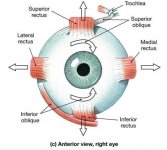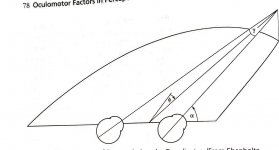Nasal side occlusion is probably due to differential vignetting.
Starting to make a bit more sense for me. I'm still missing how vignetting would be different between eyes in this case. If you were looking at something very close to your face and the eyes had to converge, this makes sense. Does it still work that way with binoculars? Doesn't sound like it should if d=infinity.
As the diagram demonstrates, the nasal eye rotates more to view the same lateral point as the temporal eye, which means that for lateral viewing there is differential vignetting. The nasal eye has more.
Seems that the eyes should be relatively parallel and in the case of looking to the extreme right edge of the field that each eye would require equal lateral rotation, right? Very possible I'm just missing how the diagram shows that, but it isn't exactly on a blinking neon sign if it does.
There are other possible complications too. As the eye rotates it also moves laterally which requires recentering to the optical axis.
This might be the heart of the matter. When the eye
moves laterally, do you mean the pupil's relative position changes, or that the center of the eyeball has a translational shift?
I kept reading a bit and tried to search with different terms as they came up, eventually leading to paper called "Axis of Eye Rotation Changes with Head-Pitch Orientation during Head Impulses about Earth-Vertical"
https://www.ncbi.nlm.nih.gov/pmc/ar...ubject changes,though Listing's plane has not
Interesting excerpt:
"Two paradigms provide evidence of a compromise between Listing's law and a perfectly compensatory VOR. First, when a subject changes gaze between an up to a down far target during a passive head rotation about Earth-vertical with the head upright in neutral position, the axis of eye rotation pitches backwards or forwards depending on the vertical position of the eye in the orbit, even though Listing's plane has not changed its orientation."
So I went back outside and tried again. Initially I noticed the pupil reaching the edges of the eyebox and got the vesica piscis shape as you mentioned in all directions. Predictable, but not what I had observed before...
Then tried again, and was unable to see (via direct view) ANY of the edges.
Finally I tried to account for vertical position and recreate what I was doing when I noticed it originally and was able to recreate it. Sounding like the answer might be a lot more nuanced and less interesting than I'd hoped, if this makes sense:
When I'd done it initially, I was in a chair, leaning forward to support my elbows with my knees, and gazing at something elevated a few degrees upward. The target height and orientation to the optics means I was already "looking up" about 20 degrees.
The nuanced part is that those different observations and their causes might be pretty freakin' irrelevant, since recreating any of this are more dependent on facial structure, nose shape, and the O.D. of the eye cups, since every one of those things is putting a bigger variable into the system than any minute change to the eye's coordinates.
You guys clearly have a better foundation for this stuff, so I'm curious if this adds up?






